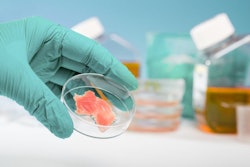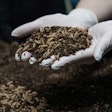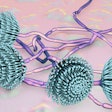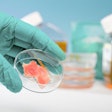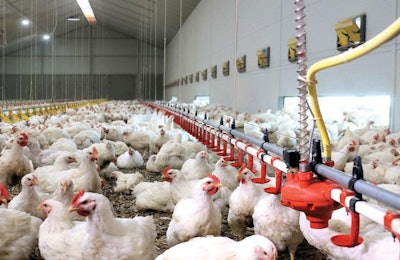
Mississippi State University’s Dr. Kelley Wamsley explores methods for evaluating feed’s role in NAE broiler production at the Midwest Poultry Virtual Conference
In the United States 52% of broilers are produced in “no-antibiotics-ever” (NAE) production systems, meaning that the birds sold under this label have never been fed or treated with antibiotics. Given the many variables that can affect flock health at any phase of the production cycle, poultry nutritionists and veterinarians face the ongoing challenge to maintain health and productivity through the use of feed additive “antibiotic alternative” solutions.
However, according 40% of respondents to Feed Strategy’s 2021 Poultry Feed & Nutrition survey, the inconsistent results they have experienced with feed additives alternatives ranks as their No. 1 challenge in making the transition.
During her presentation at the Midwest Poultry Federation Virtual Conference, “Evaluation of products for use in NAE production systems,” Dr. Kelley Wamsley, associate professor of poultry nutrition, Mississippi State University, tackled the subject and provided her tips for experimental design methods for product evaluation.
“We already know that learning how to operate NAE production is a more intense and better managed program from the pullets to breeders, from the hatchery to the feed mill to the broiler farm, and everywhere in between — and, in the beginning, there is a steep learning curve,” she noted. “Focusing on one sector or segment of this whole cycle doesn’t solve the problem; you need to use past experiences and current technology to really fine tune your management and production practices at every segment to produce healthy and efficient birds to maximize profit.”
Management/biosecurity and nutrition are the key focus areas of successful adoption of an NAE program, but other factors contribute to ensuring the health and productivity of NAE birds.
Identify NAE production goal
The first consideration when exploring new feed additives for NAE production: Is this product going to be used for prevention or for treatment?
“The individuals making these decisions for companies — veterinarians, nutritionists or both — have to weigh a delicate balance to look at how they can maintain performance, at least hopefully, but also how they’re going to treat the birds once they get sick or if they’re going to go from the approach of preventative treatments,” she said. “The goal is to find alternatives that will help provide low mortality rates and maintain good flock performance while protecting bird and consumer health — as well as preserving the environment.”
Preventative treatment costs more money up front “because you’re worried about treating the birds if the health is compromised, but if you have to treat the birds, that’s going to change your kill schedule and that causes your product to be sold under a different label for the company,” she noted.
Companies focused on the treatment side may use more “alternative” feed additives, but cost is going to be the primary driver where “they’re basically picking those based on the data that they’re presented from the [additive] companies.”
Research evaluation
When reviewing additive trails, Wamsley urges decision-makers pay close attention to the concentration levels of similar products in a category, e.g. essential oils, which is also important when plotting your own research on product efficacy.
“When you’re writing this up for publication, or interpreting data from one of these publications, looking at the level, the concentration, the application — all of those things are important to consider when you’re comparing research looking at one particular product versus another,” she said.
Wamsley identified four key markers for evaluating feed additive research and products for NAE production:
- Proof of concept
Beyond a proposed mode of action, make sure the study proves it works in the areas where claims are made, e.g., a gut health product research includes scoring of the intestines, either in a challenge model or not, and shows improvements.
- Interactions
Watch for potential interactions between different ingredients, which can have some antagonistic effects.
“Do some in-house, in vitro testing, at least, to see if there are any kind of potential interactions that may exist. Or, you know, even in vivo, that would be great,” she said.
- Proper controls
“There’s no silver bullet for an antibiotic alternative, but it’s still nice to be able to have some of these comparisons against Salinomycin or BMD whenever you’re looking at evaluating these different types of alternative products,” said Wamsley.
- Challenges vs. practical
“If you’re going to have a challenge or a practical research project to evaluate one of those products, then you need to think about what’s going to be an expected mortality that’s going to be seen in the field,” Wamsley said. Also, think about its feasible commercial application.
In practice
During her talk, Wamsley explored experimental methods and equipment used throughout the life cycle, including from the hatchery through processing. But, when looking at experimental feed considerations, however, she specifically suggests using basal diets that are formulated so only a portion is being replaced — and hopefully it’s a one-to-one replacement.
“The main thing is you don’t have different nutrient densities between your diets so making multiple batches and equally allocating them to predetermine treatments will be the best practice,” she advised.
While many feed additive alternative products exist, none will be equal to the effects of antibiotics, and one needs to consider their practical application from an experimental phase in the field.
“Ultimately, I think utilizing basic science techniques to support the practical application of these products — and using lessons learned from the past — we can progress forward to find a way to maximize bird health and production under NAE conditions,” she said.
The Midwest Poultry Federation Virtual Conference was held May 18-21, 2021. To register to view on-demand recordings of the event, visit https://midwestpoultry.com/.



